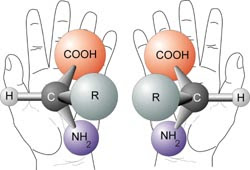A week ago, we had a very interesting Physics department colloquium by Marcelo Gleiser about his recent book, A Tear at the Edge of Creation: A Radical New Vision for Life in an Imperfect Cosmos.
He discussed his growing disillusion with string theory and the search for a "theory of everything" which is based on the predominance of symmetry. He gave important examples of symmetry breaking in nature including CP violation in the electro-weak interactions [which because of the CPT theorem implies time reversal invariance] and the unique chirality of amino acids in proteins.
Although it was a nice talk I thought it was all a bit sad to see someone who had become so enamoured with the propaganda of the reductionism in the high-energy physics community that it was painful when doubts emerged. Most of the points Gleiser was making seem to me to have been made long ago (in a more constructive sense) by Anderson in his 1972 "More is Different" article in Science, and more passionately and more recently by Laughlin in A Different Universe.
Subscribe to:
Post Comments (Atom)
Hikes around Brisbane I recommend
My colleague, Carla Verdi, suggested I write this post. Here are a few short hikes that I enjoy. I list them in order of distance from Bris...

-
This week Nobel Prizes will be announced. I have not done predictions since 2020 . This is a fun exercise. It is also good to reflect on w...
-
Is it something to do with breakdown of the Born-Oppenheimer approximation? In molecular spectroscopy you occasionally hear this term thro...
-
Nitrogen fluoride (NF) seems like a very simple molecule and you would think it would very well understood, particularly as it is small enou...




I did not see the point / problem with the existence of broken symmetries in nature. In any finite group there will be operations that are not a symmetry. The fact that CP is not a symmetry seems less profound (or at least, no more profound) than the fact that CPT IS a symmetry.
ReplyDelete